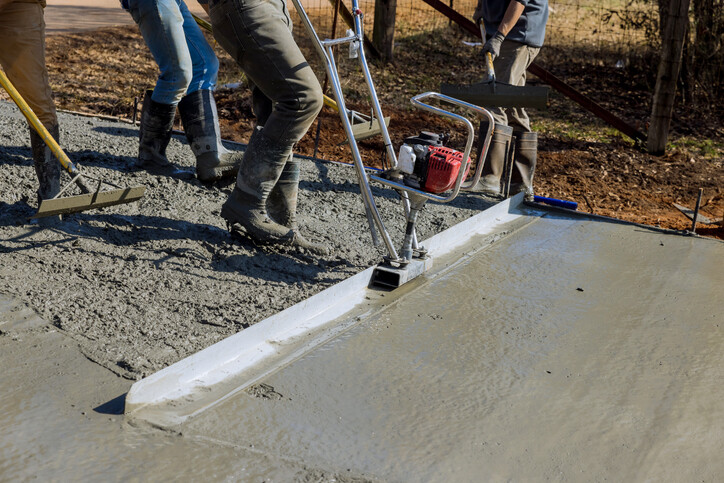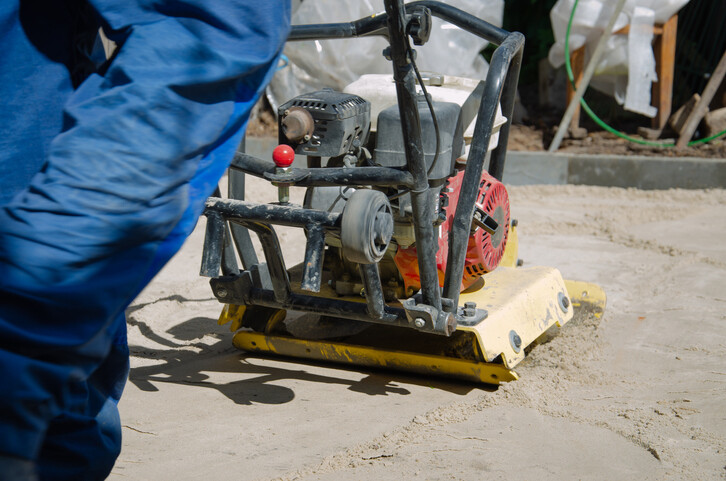 Concrete is a versatile and durable material widely used for a range of applications, from driveways and patios to warehouse floors, foundations and more. To achieve a high-quality concrete surface, it’s important to understand the proper methods for preparation, pouring, compacting and finishing. This guide will walk you through the essential steps of working with concrete, the tools you’ll need and how to ensure a long-lasting and professional result. Remember that at PSM Tool Hire we provide an extensive range of concrete and compaction equipment available for hire, as well as friendly advice on the best tools for your projects.
Concrete is a versatile and durable material widely used for a range of applications, from driveways and patios to warehouse floors, foundations and more. To achieve a high-quality concrete surface, it’s important to understand the proper methods for preparation, pouring, compacting and finishing. This guide will walk you through the essential steps of working with concrete, the tools you’ll need and how to ensure a long-lasting and professional result. Remember that at PSM Tool Hire we provide an extensive range of concrete and compaction equipment available for hire, as well as friendly advice on the best tools for your projects.
What is Concrete and What Are Its Properties?
Concrete is a composite material made up of cement, aggregates (such as sand and gravel) and water. When mixed, these ingredients undergo a chemical reaction known as hydration, which causes the mixture to harden into a strong, durable surface.
Components of Concrete:
- Cement: A binding agent that holds the mixture together and causes it to harden.
- Aggregates: Materials such as sand, gravel, crushed stone, or specialised items like glass or pebbles that add strength and texture to the concrete.
- Water: Activates the cement, enabling the chemical reaction that cures the concrete.
Properties of Concrete:
- Durability: Concrete resists weathering, wear and heavy loads, making it ideal for driveways, foundations and warehouse floors.
- Strength: Concrete can support substantial weight, ensuring it is suitable for areas with heavy traffic or weight-bearing requirements.
- Versatility: Concrete can be finished in a variety of textures and appearances to suit different aesthetic preferences.
- Low Maintenance: When properly sealed, concrete surfaces require minimal upkeep, making it an efficient choice for many applications.
How Do You Pour a Concrete Floor? (Step-by-Step Guide)
Successfully pouring concrete requires careful preparation and attention to detail. Follow these steps for a professional-quality result:
Preparation:
Before pouring concrete, you must first excavate and compact the area where the concrete will be laid. This step ensures that the foundation is level and stable. Install formwork around the area, and if necessary, include reinforcement such as steel bars or wire mesh (rebar) to improve the concrete’s strength.
Mixing and Pouring:
Once the area is prepared, mix the concrete using a concrete mixer, ensuring a consistent blend of cement, aggregates and water. Then, pour the concrete evenly into the formwork, ensuring it fills the entire space.
 Levelling:
Levelling:
Use a screed (a long, straight edge) to level the poured concrete, removing any excess and ensuring the surface is even. The screed will help to flatten the concrete and prepare it for the next steps.
Compaction:
To ensure the concrete is dense and free of air pockets, use a concrete poker unit (vibrator) or a compactor plate to consolidate the mixture. This step removes any trapped air, making the concrete stronger and reducing the risk of weak spots or cracks.
Finishing:
After the concrete is poured, leveled and compacted, it’s time to apply the desired finish. Whether you’re opting for a broom finish, smooth finish or exposed aggregate finish, this step gives the concrete its final look and texture.
Curing:
Concrete requires proper curing to reach its full strength. Keep the surface moist for several days to ensure the hydration process continues. This is a critical stage for developing durability.
Sealing (Optional):
To enhance the longevity and appearance of the concrete, you can apply a sealant. This step is optional, but it protects the surface from stains and damage while providing a polished look.
What Are the Most Common Concrete Finishes?
Once the concrete is poured and compacted, you can choose from a variety of finishes, each with its own benefits. The most common finishes include:
Broom Finish
A broom finish is achieved by dragging a stiff broom over the freshly poured concrete, creating textured lines that add grip.
Advantages: Ideal for outdoor areas like driveways and walkways, as it provides a non-slip surface.
Disadvantages: While functional, it’s less visually striking than other finishes.
How to Achieve a Broom Finish:
- Pour and level the concrete.
- Use a float to smooth the surface before applying the broom finish.
- Drag a specialised broom lightly over the surface before the concrete sets fully.
Smooth Finish
A smooth finish provides a sleek and polished surface, perfect for spaces such as warehouses or garages where ease of cleaning is essential.
Advantages: Ideal for smooth, easy-to-clean surfaces.
Disadvantages: Can become slippery when wet.
How to Achieve a Smooth Finish:
- Pour and screed the concrete.
- Use a bull float or power float to achieve a smooth, even surface.
- Apply a sealant for added protection and durability.
Exposed Aggregate Finish
An exposed aggregate finish reveals decorative materials like pebbles, glass or stones embedded in the concrete.
Advantages: Offers an anti-slip surface and a decorative look, making it a great choice for patios or garden paths.
Disadvantages: Requires more effort and skill to achieve.
How to Achieve an Exposed Aggregate Finish:
- Pour and screed the concrete.
- Use a bull float to smooth the surface.
- Apply decorative aggregates on top of the wet concrete and press them down with a float.
- Wash away the top layer of concrete to expose the aggregates beneath.
 What is Compaction?
What is Compaction?
Compaction is a crucial step in both the preparation of the ground and the concrete itself. By compressing the soil or gravel base using a compactor plate before pouring concrete, you create a stable foundation that reduces the risk of settling or cracking. Additionally, compacting the concrete itself ensures that trapped air is removed, creating a stronger and more uniform mixture. Proper compaction improves the concrete’s durability and helps prevent long-term issues.
What Are the Basic Tools and Equipment Necessary for Concrete Pouring?
To successfully complete a concrete project, you’ll need a few essential tools:
- Concrete Mixer: Ensures a consistent blend of cement, aggregates and water for a uniform mixture.
- Concrete Poker Unit (Vibrator): Removes air pockets and excess water from freshly poured concrete.
- Compactor Plate: Prepares the ground by compacting soil or gravel before the concrete is poured.
- Screeds: Used to level and smooth the freshly poured concrete to the desired thickness.
- Floats: Refines the concrete surface after screeding, ensuring a smooth, even finish.
Why Choose PSM Hire for Concreting Equipment Hire?
For professional-quality concreting projects, PSM Hire offers a wide range of concreting equipment, including mixers, vibrators, compactors, screeds and finishing tools. Hire the right tools for your job at competitive rates, with expert advice and top-tier customer service. Contact PSM Hire today at 01462 684 224 or email info@psmhire.co.uk. Visit PSM Hire to learn more.
